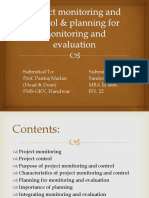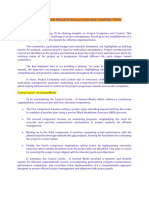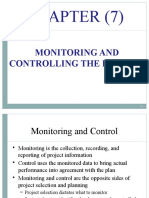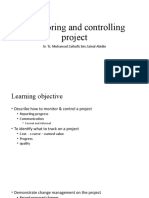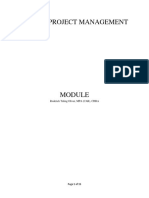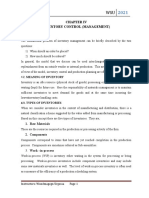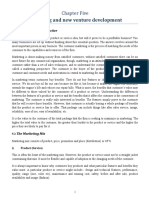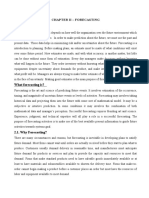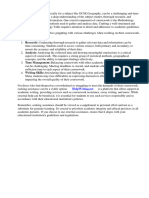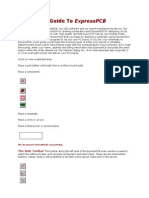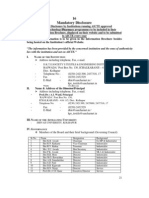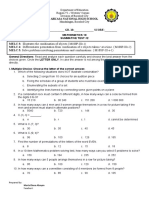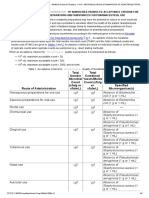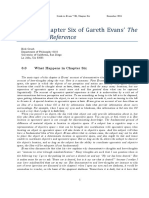CHAPTER 5
PROJECT MONITORING AND EVALUATION SYSTEM
The basis of project monitoring systems is to track actual
progress against planned progress at any given time. This covers
financial progress (monitoring of actual expenditure against
budgeting expenditure) as well as the progress of project activities.
Monitoring systems should be considered alongside the
implementation plan because it is the targets set out in this plan
which forms the targets for monitoring. The whole system is therefore
often referred to as an “integrated planning, implementation and
monitoring system” (IPIMS).
Monitoring systems should:
At all times be concerned with future progress.
Be simple and cost effective.
Be able to detect deviations quickly and accurately.
Be verifiable.
When designing a monitoring system, the project formulation should
keep the following points in mind:
Identify key personnel or informants for the monitoring
information. These could include line mangers, accountants,
contractors and suppliers etc.
Indicate frequency of data/information collection time.
Remember that data is only effective once it has been processed.
Identify responsibilities for data processing. Assign also
responsibilities to act on the result of these data.
Try to attain the right combination of speed and accuracy.
Sometimes a trade-off has to be made between the two, with
information that is extremely accurate leading to delays in
taking effective remedial action.
1|Page
� Make sure that the monitoring system only intends to
processes that data which is necessary. Monitoring
information increases workload so it is important that only the
most essential data is requested for processing.
Monitoring systems in themselves are ineffective unless they are
linked to an effective control system which will allow the manger
to take swift and effective action to remedy any deviations
from the implementation plan.
Systems concerned with implementation measure the
project’s effectiveness in converting inputs to outputs; while
monitoring systems concerned with operations measure the
project’s effectiveness in converting outputs into immediate
and wider objectives.
Information acquired through monitoring systems can be divided
into three categories:
Monitoring of physical progress
Monitoring of financial progress
Monitoring the quality of project outputs.
MONITORING PHYSICAL PROGRESS:
The primary purpose of physical progress monitoring is to ensure
whether project activities are on schedule. This can be achieved
through milestone (target) monitoring and time chart
monitoring.
Milestone monitoring involves the use of project milestones which
were identified as part of the project implementation plan. The actual
date on which these milestones were reached can be entered in table
form or on the Gantt chart. Milestone monitoring provides a
retrospective record of project progress, but it is unable to provide us
with information about activities which are still in progress.
Time chart monitoring is a method which is used to anticipate
whether or not milestones will be reached on schedule.
2|Page
�When dealing with physical progress of an activity there are three
possible scenarios:
Activity outputs can be quantified as a single number. This is
relatively simple to monitor. for example, if the activity was to
print a certain number of textbooks then both the physical target
and progress to date can be expressed in terms of this single
number (for example, 250 books printed out of a target of 1000).
Activity outputs can be measured and valued. This is the case
with the construction of buildings and roads. progress towards
meeting physical targets should be expressed as:
When dealing with direct labor the planners must be careful not
to equate the value of the work done with financial spending.
The planners should devise methods to measure actual physical
progress.
Activity outputs cannot be directly valued. This is the case in
activities such as training or in supply-only contracts. These
activities should use milestones to mark the beginning and end
of each separate activity phase. if this is not possible, physical
progress can be expressed as:
Time spent to date X 100(%)
Total time to complete
This can be problematic because the time taken may not bear
any relation to the actual amount of physical progress towards
activity completion. Once physical progress has been monitored
for all ongoing activities, it is possible to plot this information
against the implantation plan in the form of a bar chart.
MONITORING FINANCIAL PROGRESS:
This involves comparing actual expenditure against the financial
plan (budget) produced as part of the implementation plan. The
project must therefore have a cost reporting system in place to
3|Page
�enable a comparison of actual and predicted costs. It is unwise to rely
on existing accounting systems to provide this information as these
systems are liable to be slow and to categorize expenditure using
different methods to those desired by the project manger.
As many authors note “public sector mangers will need to take
particular care that they keep a measure of overall spending of the
project against overall budget……managers are not able to spend
above each year’s authorized budget, so that cost over-runs are met
by delaying implementation, or reducing the scope of the project to
compensate.”
Once the manger has access to accurate cost data, it is possible to
utilize this information in the process of project cost control. Using
the following relationship can do this:
Cost of work to date = Cost of work remaining
Value of work to date Value of work remaining
The information gained through this calculation can then be entered
in tabular form.
MONITORING THE QUALITY OF PROJECT OUTPUTS:
This involves ensuring that outputs are delivered according to
specification. This is normally done through a system of direct
inspection and supervision. A formal agreement between the
implementing agency and the project owner that project outputs are
satisfactory is known as ‘signing-off’. Each project will have its own
quality assurance features in operation and it is important that the
quality control aspect is not overlooked during project design.
EVALUATION:
Evaluation is the structured process by which a project activities and
achievements are assessed and understood. It provides information
for those who are involved in the project such as managers,
promoters, funders and/or policy makers. Evaluation in addition to
4|Page
�quantitative questions attempts to answer also qualitative questions.
Evaluation could be ongoing (mid term), terminal or ex post. A good
evaluation system in a project from the outset may assist the project
implementers in identifying difficulties that hinder the progress as
planned and avoid repeating mistakes in future endeavors. It is
therefore, crucial to identify the main actors for the evaluation
exercise during the project formulation.
The preliminary function of evaluation after project completion is to
use data on the performance of projects in such a way that new
projects can learn from experience.
PROJECT SUSTAINABILITY:
A project is sustainable if its net benefits continue throughout the life
of the project at a level sufficient to meet the predetermined
objectives. Sustainability is, therefore, the ability of a project under
consideration to continue operation or provision of services and/or
production without interruptions for the period under design. It also
includes the managerial and technical capacity and capability of the
project personnel in the operation and running of the project to
meeting its desired objectives.
The aim of any development project is to meet its predetermined
objectives/goals on sustainable basis. If the project formulators fail to
consider what will happen upon completion of the project’s
implementation phase, then however well implemented, the project is
liable to encounter serious problems in providing the required
services and/or production.
Full coverage and exhaustive analysis of project aspects such as:
demand/need, technical, environmental, social, institutional,
financial, and economic analyses are critical for the sustainability
of a project under consideration. Furthermore, risk, uncertainty and
distributional analysis are vital to ensure the sustainability of a
project. Project planning, therefore, should also need focus on project
handover, operations, maintenance and termination arrangements so
that implementation and operation phases are smooth and clear.
5|Page
�To ensure that the transition between the project’s implementation
and operation phase is as smooth as possible consider the following
strategies in the formulation of the proposed project:
Ensure that project handover, operation and termination
arrangements are properly planned and responsibilities
identified from the outset.
Ensure that the handover operation and commissioning period is
smooth in order to use newly created facilities and utilities to
use them in the most efficient and effective manner.
Ensure that project handover procedures have included
acceptance tests, relevant safety and quality standards set by
the project or responsible authority.
Ensure that the process of project operation is properly
monitored and changes to be achieved during operation are
evaluated.
Ensure that adequate maintenance facilities and operation
arrangements are in place for the proposed technology or
system of operation.
Ensure that the institutional and financial arrangements for
project operations should be clearly outlined at the project
formulation stage.
Ensure that adequate financial provision has been made for
maintenance needs, which may arise during operations.
Examine thoroughly that financing arrangements for future
operation, especially with relation to the funding of recurrent
costs.
Ensure that the body responsible for project operations should
have adequate organizational capacity in order that it will be
able to sustain operations.
6|Page
� Ensure that proper management information system is in place
with practically applicable tools to successfully implement and
operate a project.
Ensure that the project’s technical design utilizes technology,
which is easy to maintain within the environment in which it will
operate.
Summary of Project Analysis and Overall Decision Project
Profile
Project Title: _________________________________________________
Project Code: ________________________________________________
Specific area where project will be implemented:
____________________
Sector within which a project will be implemented:
__________________
Responsible Authority: ________________________________________
Scheduled Start Date: _________________________________________
Scheduled completion
Date:____________________________________
Total Budget: ________________________________________________
Sources and Terms of Project Financing:
__________________________
Summary of Project Analysis:
Issues of Project Goo Satisfac Unsatisfac Comme
Preparation d tory tory nts
Technical aspect
Environmental
aspect
7|Page
� Social aspect
Institutional aspect
Financial aspect
Economic aspect
Sensitivity analysis
and Risk
Overall Decision:
Accept Reject Redesig Comment(action to be
n taken/by whom)
8|Page


















